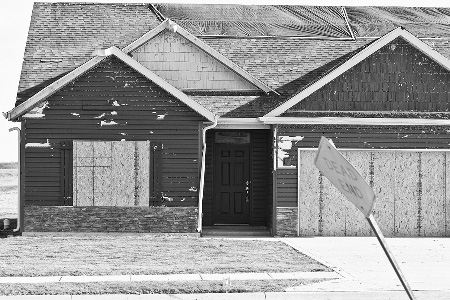Insurance Market Troubles

The insurance market for HOAs has been volatile, at best, for the last decade. 2023 has been horrendous on a number of fronts. For most associations, premium increases have been somewhere between 20-40%. For some, the primary business/structural policy premium has doubled. And for a rapidly growing number of associations, surprising news of non-renewals has left them scrambling to find coverage elsewhere in an already consolidated market. Unfortunately, the future doesn’t give any optimistic signs of improvement. Although Minnesota is not alone in this troubling trend, we have been hit harder than most states. For five consecutive years, Minnesota has ranked in the top-5 in the nation for losses paid out. Florida has hurricanes. California has wildfires. Minnesota is the bullseye for hail. Minnesota has now been labeled as a “catastrophic state” by most insurance carriers, shrinking the market’s interested providers and inflating the rates for those offering coverage. One local industry expert calculated that for every $1 of premium collected, the insurance market has paid out $1.44 in losses for the multi-family sector. In response, carriers have not only increased premiums, but also wind-hail deductibles have increased to the point they no longer even pay out for hail damage; they’ve increased the number of “exclusions” on policies, and thus reduced the scope of coverage and further complicating claims; they have decreased the “cash value” and valuations on claims. While premium increases have been challenging, the real trouble in 2023 has been the shrinking market of providers and non-renewals. One industry expert with Insurance Warehouse estimated that there are only two or three carriers that will even write new policies for a townhome-style association right now. The big names, such as American Family, State Farm, Farmers, etc., have steadily been non-renewing associations with claims history and choosing to refrain from writing any new policies for multi-family developments. Many associations have had to go to the “secondary market” of carriers, which only fulfills the association’s requirement to have insurance, but offers little coverage and inflated premiums. The insurance market for associations is really in a state of crisis. In summary, carrier selections are becoming fewer, non-renewals more common, and drastically increasing premiums are the norm. Associations need to be aware of these challenges and be prepared financially.
HOA Insurance Policies

For residents and HOA board members, there seems to be a lot of lingo when it comes to insurance. How do you know which policies cover which property? How do you know what insurance requirements to make when managing an association? We’ve explained the “walls out” and “walls in” policies to help you understand what each one covers. Master Policy This policy is also known as the HOA insurance policy and covers liabilities or damages in common areas or on the exterior of your home. The term “walls out” can also be used to describe what the master policy will cover. However, this doesn’t mean that absolutely everything on the exterior will be covered; if a storm results in extensive damage, residents will have to help pay the association’s deductible. This is what’s known as loss assessment, and it’s a good idea to add this to your HO6 policy so you’re not paying out of pocket. In addition to exterior damages, the master policy also covers liabilities in common areas. If someone were to slip by the pool and decided to sue the HOA, the liability portion of the policy would protect residents from having to pay special assessments for lawsuit fees. HO-6 Insurance Your HOA’s master policy isn’t going to cover your personal property, or anything “walls in.” If you live in a condo or any other shared space, you’re going to need HO-6 insurance. Besides insuring your personal belongings, your association’s master policy won’t likely cover anything inside the bare walls of your unit. You would be responsible for getting coverage for unit structural items such as: Carpeting, ceramic tiles, hardwood floors Plumbing fixtures Light fixtures Built-in appliances Kitchen cabinets Wall coverings And, as mentioned previously, it’s a good idea to add loss assessment coverage to your HO-6, if not already required by your association.
Loss Assessments

In the Midwest, we’re all too familiar with summer storms and the damage they can cause to houses and buildings. HOA reserve funds are available for unexpected damages or emergencies, but using them could cause the association to be short on funds for future projects and non-insurance related repairs. Understanding how your insurance policies work can make claims and repairs a much smoother process. With heavier storms, sometimes the master policy isn’t enough to cover damages. Unit owners may need to help pay for repairs for damages to shared buildings, such as shingles being torn off a condo roof. The master policy can only pay up to coverage limits, so it’s up to the homeowners to pay the rest. The amount owed is assessed by the association, and as an owner, it is your responsibility to pay your share. However, needing to pay for community damages doesn’t mean you’re paying out of pocket. It’s a good idea as a homeowner to get Loss Assessment Insurance under your HO6 policy, if not already required. In addition to property damage, this coverage helps to pay for injuries on the premises, liabilities, and deductibles under the master policy. Homeowners who have appropriate coverage under their HO6 policy can submit a claim to their insurer. As a member of the HOA board, consider making it a requirement for owners to have loss assessment coverage to avoid any collection problems, as these assessment costs can often exceed $10,000 per unit. Boards should also work with their HOA management company to make sure that they are navigating these issues correctly. Insurance claims and loss assessments can seem confusing, but Sharper Management is here to help guide you through those difficult times.
Getting Ready to Sell in an HOA

Prepping for the sale of your home doesn’t need to be an arduous task. Just like selling any other single-family home, selling your townhouse or condo may require a few interior updates and fixes, but there are also a few simple things that you can do that will go a long way in adding appeal to your property. Simple Tips for Selling Clean and re-organize your space – As long as you’re trying to sell your CIC property, you will need to keep it clean and organized in case of any last-minute showings. Rooms should be re-arranged to appear spacious, and storage areas should be emptied, when possible, to make them appear larger. Depersonalize your space – Take down or remove items such are your photos on the wall, religious items, knickknacks, worn-down furniture, and other personal items. Potential buyers want to envision themselves in the space, and a non-personalized space can help them do that. Little updates go a long way – Updating things like cabinet hardware or outlet covers will help the space feel updated without a lot of effort. If your walls aren’t already neutral colors, then re-paint them so they’ll appeal to a wide range of buyers. In general, a new coat of paint will make a space look better. Focus on your kitchen and bathroom – The kitchen and bathroom are big sellers in any home. Make sure they are clean! If your bathtub has mold in the grout, scrub it or reroute the lines to freshen them. Remove clutter from your kitchen countertop space. This will make even a small kitchen seem larger. Be flexible with your showings – Stay courteous and responsive when dealing with potential buyers. Flexibility when setting up a showing will help move you to sale faster. Choose the right realtor – Make sure you choose a realtor who knows how to market an HOA property. Ask questions about where they plan to market your home. Does include a full range of the most popular real estate websites such as Realtor.com? Will they bring in a professional photographer to ensure your online photos make your home look its very best? With these helpful tips, you should be able to expertly present your property to potential buyers. Remember to also play up the benefits of your HOA. As the seller, you’ll need to provide resale documents to your potential buyer. You can find this information on our website. Visit sharpermanagement.com and look for the Resale Disclosures link in the menu bar. Or, click here.
Understanding Insurance in a Homeowners Association

Understanding insurance in a multi-unit dwelling/Association can be daunting. What does the Association’s master policy cover? What does my personal insurance policy cover (usually referred to as an “HO6” policy)? Which policy kicks in for a particular loss? Unfortunately, there are a number of variables that makes it impossible to give a universal answer to these questions. Here are some important concepts to understand. Coverage – In general, the most important thing to do is read your Governing Documents (typically the Declarations) and try to understand what the Association is responsible for insuring. Does it say the Association will insure wall coverings, floor coverings, cabinets, fixtures, etc.? These are some common terms used to state it is an “all in” type of a policy. Another important distinction is whether the Association will or will not insure “betterments and improvements” or is it “original specs.” If none of these items are listed, it may be stated or implied that the policy is a “walls out” policy and nothing on the interior of the unit is covered. You should discuss with your personal insurance agent what the Documents state on insurance coverage. One of the first questions your agent should ask when writing your policy is to review the Governing Documents. It can also be helpful to call the Association’s agent and verify what, in fact, the Association has for scope of coverage. Even better, tell your agent they should contact the Association’s agent and “cross the T’s and dot the I’s” Remember, the role of your HO6 policy is three-fold. 1.) at a bare minimum, to insure construction of the unit (sometimes known as “real property”) up to the Association’s deductible. 2.) to insure components of the property outside of what the Association’s master policy covers. 3.) to insure your personal items/property. In short, understand the Association’s insurance coverage and bridge all gaps with your HO6 policy. *** The amount of coverage to carry on an HO6 policy is completely subjective and up to you, as the owner. Again, at a bare minimum, you want to carry coverage up to the Association deductible on construction already covered under the master policy. Loss Assessment – Another important aspect of insurance when living in an Association is “Loss Assessment Coverage.” Again, read your Governing Documents. Some Association’s legally require homeowners to carry this type of policy. Loss Assessment Coverage provides protection to the owner should the Association have a loss that exceeds the coverage limits of the master policy, or should/when the Association assess the owner for their share of the master policy deductible. Loss Assessment Coverage would help the homeowner with such an assessment. The amount to carry is very subjective and up to you and your agent to determine – but at a minimum, it should be equivalent to the master policy deductible. Deductible – Which brings us to the last important component of Association insurance – deductible. It is very important to know what the Association’s master policy deductible is. And to stay on top of it from year to year, as it can change. In most cases, the master policy will not kick in coverage unless a Loss exceeds the deductible. Your HO6 would pay if it is under the deductible. If the Loss does, in fact, exceed the deductible, you/your HO6 would be responsible for the amount up to the deductible. For example – you live in a condo building and the master policy is an “all in” policy with a $10,000 deductible. There is a $15,000 water loss in your unit. Your HO6 policy covers the first $10,000 – while the Association’s policy covers the remaining $5,000. To Recap – read your Governing Docs to understand the Association’s insurance scope. Talk in depth with your agent and the Association’s agent, if needed, to develop an HO6 policy that bridges all coverage gaps and requirements. Consider carrying, if you are not already required to, Loss Assessment Coverage. And finally, stay on top of your Association’s policy each year as it renews to make necessary adjustments to your HO6 policy.
Storm Damage and Your HOA – Choosing a Restoration Company

Summer storms in Minnesota are shaping up to be a regular occurrence in 2017. The June storm that caused significant damage in the northern metro prompted us to review a few things you may want to know about storm damage and living in an HOA. First off, all HOAs have their own set of governing documents that dictate protocol for things such as external maintenance and restoration. Generally, your HOA’s insurance protects the exterior of your home (studs out) while your homeowner’s policy will cover the interior (studs in). This may differ in townhome associations that are free-standing (those with no shared walls or roof lines). With that being said, in the event of a major storm that creates exterior damage to your HOA such as hail damage, loss of roofing, trees falling on your home etc., the Association’s policy covers your exterior. What may be confusing is coverage for damage on the inside of your home as the result of storm damage. An example of this is water damage caused by a hole left in the roof after a storm. Your insurance (you) are responsible for the water damage inside your unit. Restoration companies that specialize in 24-hour response are critical in mitigating further damage from a storm event. When we look for storm damage companies, this is one of the first things we ask of the restoration company. What mitigation and temporary things do you put in place to minimize further damage. Keep in mind an emergency response to the situation is not the final restoration. Do not expect a team to completely replace your Association’s roof the next day. The emergency response will secure the property against the elements. It will stop the rain, wind, and heat/cold from entering your home. Sharper Management also looks for companies with good reputations. Online testimonials, membership in local and national organizations, and being a member of the BBB are all pieces we consider when bringing companies to the table for your Board to review. The company offering the bottom line price may not be the best choice for your restoration project. When a restoration project is to start, Sharper Management works with your Board to notify residents of the project schedule. Sometimes it is necessary for work to begin in the early morning to ensure timely completion. This becomes a significant consideration when many properties in an area have been damaged. A little inconvenience, such as a 7am start, is worth it in the long run to restore your home as quickly as possible.
Things to Know Before Selling in an HOA

As spring rapidly approaches in Minnesota, you may be thinking of selling your townhome or condominium. In addition to fixing a few things and adding a fresh coat of paint to your walls, there are also a few actions and items you’ll want to familiarize yourself with regarding your HOA before listing your home. Because you live in a shared community, there are rules and guidelines in place for the protection of all owners in your association. Knowing these things before you have an offer in-hand will make your sale a smooth process. A review of the Governing Documents for your association is a good idea to know what kind of things may be questioned about your association early in your selling process. If you need an updated copy of your Governing Documents, they are typically available on your Association’s website through Sharper Management. As the seller, you will be required to provide resale disclosure documents about your HOA. These documents contain a wealth of information for a buyer that include things like: * Pending litigation about the association * Up-to-date information about assessments * The association’s financial status * Covenants and restrictions within the HOA * Any violations about the unit you are selling * Governing documents for the HOA You may request resale disclosures through the Sharper Management website or visit this link directly to learn more. https://www.condocerts.com/
Understanding Insurance in an HOA
Understanding insurance in a multi-unit dwelling/Association can be daunting. What does the Association’s master policy cover? What does my personal insurance policy cover (usually referred to as an “HO6” policy)? Which policy kicks in for a particular loss? Unfortunately, there are a number of variables that makes it impossible to give a universal answer to these questions. Here are some important concepts to understand. Coverage – In general, the most important thing to do is read your Governing Documents (typically the Declarations) and try to understand what the Association is responsible for insuring. Does it say the Association will insure wall coverings, floor coverings, cabinets, fixtures, etc.? These are some common terms used to state it is an “all in” type of a policy. Another important distinction is whether the Association will or will not insure “betterments and improvements” or is it “original specs.” If none of these items are listed, it may be stated or implied that the policy is a “walls out” policy and nothing on the interior of the unit is covered. You should discuss with your personal insurance agent what the Documents state on insurance coverage. One of the first questions your agent should ask when writing your policy is to review the Governing Documents. It can also be helpful to call the Association’s agent and verify what, in fact, the Association has for scope of coverage. Even better, tell your agent they should contact the Association’s agent and “cross the T’s and dot the I’s” Remember, the role of your HO6 policy is three-fold. 1.) at a bare minimum, to insure construction of the unit (sometimes known as “real property”) up to the Association’s deductible. 2.) to insure components of the property outside of what the Association’s master policy covers. 3.) to insure your personal items/property. In short, understand the Association’s insurance coverage and bridge all gaps with your HO6 policy. *** The amount of coverage to carry on an HO6 policy is completely subjective and up to you, as the owner. Again, at a bare minimum, you want to carry coverage up to the Association deductible on construction already covered under the master policy.Loss Assessment – Another important aspect of insurance when living in an Association is “Loss Assessment Coverage.” Again, read your Governing Documents. Some Association’s legally require homeowners to carry this type of policy. Loss Assessment Coverage provides protection to the owner should the Association have a loss that exceeds the coverage limits of the master policy, or should/when the Association assess the owner for their share of the master policy deductible. Loss Assessment Coverage would help the homeowner with such an assessment. The amount to carry is very subjective and up to you and your agent to determine – but at a minimum, it should be equivalent to the master policy deductible. Deductible – Which brings us to the last important component of Association insurance – deductible. It is very important to know what the Association’s master policy deductible is. And to stay on top of it from year to year, as it can change. In most cases, the master policy will not kick in coverage unless a Loss exceeds the deductible. Your HO6 would pay if it is under the deductible. If the Loss does, in fact, exceed the deductible, you/your HO6 would be responsible for the amount up to the deductible. For example – you live in a condo building and the master policy is an “all in” policy with a $10,000 deductible. There is a $15,000 water loss in your unit. Your HO6 policy covers the first $10,000 – while the Association’s policy covers the remaining $5,000. To Recap – read your Governing Docs to understand the Association’s insurance scope. Talk in depth with your agent and the Association’s agent, if needed, to develop an HO6 policy that bridges all coverage gaps and requirements. Consider carrying, if you are not already required to, Loss Assessment Coverage. And finally, stay on top of your Association’s policy each years as it renews to make necessary adjustments to your HO6 policy.
